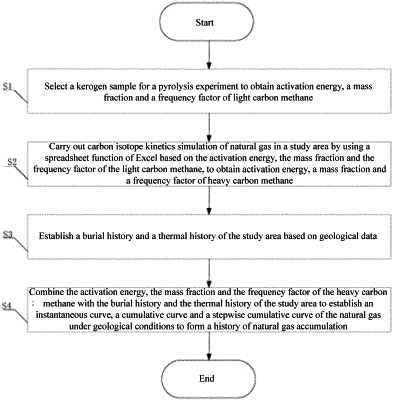| CPC G16C 10/00 (2019.02) [G01N 33/241 (2013.01); G16C 20/70 (2019.02); G01N 31/12 (2013.01)] | 9 Claims |

|
1. A method for forming a history of natural gas accumulation by using carbon isotopes by a pyrolysis experiment, comprising the following steps:
S1, performing a pyrolysis experiment on a selected kerogen sample to obtain activation energy, a mass fraction and a frequency factor of light carbon methane;
S2, carrying out carbon isotope kinetics simulation of natural gas in a study area based on the activation energy, the mass fraction and the frequency factor of the light carbon methane, to obtain activation energy, a mass fraction and a frequency factor of heavy carbon methane;
S3, establishing a burial history and a thermal history of the study area based on geological data; and
S4, combining the activation energy, the mass fraction and the frequency factor of the heavy carbon methane with the burial history and the thermal history of the study area to obtain an instantaneous curve, a cumulative curve and a stage cumulative curve of the natural gas under geological conditions to form a history of natural gas accumulation;
wherein step S2 comprises the following steps:
S201: expanding the activation energy and the mass fraction of the light carbon methane, and setting expansion values as initial values of the activation energy and the mass fraction of heavy carbon methane;
S202: calculating a frequency of the heavy carbon methane according to the frequency factor of the light carbon methane, wherein the frequency factor of the heavy carbon methane is expressed as follows: A13C=1.02×A12C wherein, A13C represents the frequency factor of the heavy carbon methane, and A12 represents the frequency factor of the light carbon methane;
S203, calculating conversion rates and reaction rates of total reaction light carbon methane and heavy carbon methane precursors by the activation energy, the mass fraction and the frequency factor of the light carbon methane and the initial values of the activation energy and mass fraction of the heavy carbon methane and the frequency factor thereof;
S204, calculating a carbon isotope cumulative amount according to the conversion rates and the reaction rates of the total reaction light carbon methane and heavy carbon methane precursors as well as the pyrolysis experiment data, wherein the carbon isotope cumulative amount is expressed as follows: δ13C (t)=[R0F(t)/F*(t)/Rstd−1]1000, where R0=(δ13C0/1000+1)Rstd, wherein δ13C(t) represents a carbon isotope cumulative amount at time t; R0 represents an initial carbon isotope ratio of the methane precursors; F(t) and F*(t) represent the conversion rates of the total reaction heavy carbon methane and light carbon methane precursors, respectively; δ13C0 represents an initial carbon isotope amount, Rstd represents a standard ratio of Pee Dee Belemnite (PDB);
S205, setting an activation energy difference ΔEa between the heavy carbon methane and the light carbon methane as a variable value;
S206, obtaining a target value according to a carbon isotope measured amount from the pyrolysis experiment and the carbon isotope cumulative amount, wherein the target value X is expressed as follows: X=Σt|δ13C*(t)−δ13C(t)| wherein, δ13C*(t) represents a carbon isotope measured amount at time t, and δ13C(t) represents a carbon isotope cumulative amount at time t;
S207, establishing a constraint for obtaining the activation energy and mass fraction of the heavy carbon methane; and
S208, fitting the target value by using a nonlinear interior point method according to the constraint; determining whether the target value is close to a preset limit value 0 during the fitting process; if yes, completing the fitting to obtain the activation energy, mass fraction and frequency factor of the heavy carbon methane; otherwise, returning to step S205.
|